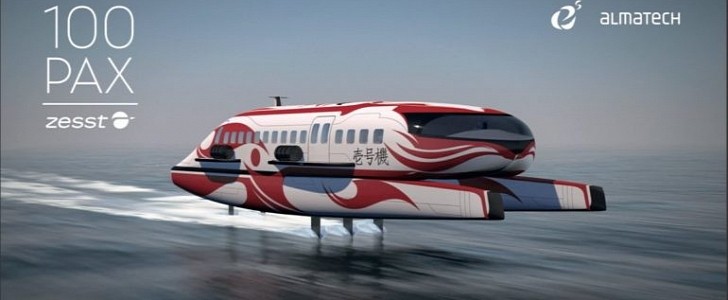Developed by Swiss space and naval engineering company Almatech, the innovative Zero Emissions Speed ShuTtle (ZESST) will be introduced in Japan, after a recent partnership with Japanese ocean shipping provider, e5 Lab.
Sustainable alternatives to waterborne public transport systems, such as electric ferries, are becoming more and more important in various cities all over the world, where people practice commuting by boat. Companies like e5 Lab want to take things even further, by introducing Mobility as a Service (MaaS) on water, and Japan, an island country, seems like an ideal location for this.
People in Japan could soon be enjoying what ZESST’s manufacturer describes as “a flying carpet experience”. That’s hard to prove unless you’re actually on the shuttle, but it sure sounds exciting. What’s certain is that ZESST is a zero-emission, high-speed boat, born on the shores of the Geneva lake.
Almatech wanted to create a shuttle that would be fast, eco-friendly and wave-free (hence the flying carpet metaphor). By using its own expertise in space technology, together with the latest advancements in hydrogen power generation and clean propulsion, the Swiss company developed a futuristic-looking, aerodynamic vessel that’s perfectly adapted for public transport, while protecting the environment.
The vessel’s electrical motors are powered by hydrogen and fuel cells and it can cruise at 30 knots while also being energy-efficient. Its unique design, based on hydrofoils and slender hulls, reduces wave generation. And this is important not just for a smooth sail, but mostly because boat-generated waves also have a negative impact on the environment.
The high-speed shuttle was designed to be customizable, meaning that it can be used to transport passengers or freight and the design can be adapted to various sizes and capacities, ranging from 50 to 400 passengers, or from 4 to 36 tons.
The Japanese version of ZESST is only a prototype for now, with plans to become a high-speed passenger shuttle in the near future.
People in Japan could soon be enjoying what ZESST’s manufacturer describes as “a flying carpet experience”. That’s hard to prove unless you’re actually on the shuttle, but it sure sounds exciting. What’s certain is that ZESST is a zero-emission, high-speed boat, born on the shores of the Geneva lake.
Almatech wanted to create a shuttle that would be fast, eco-friendly and wave-free (hence the flying carpet metaphor). By using its own expertise in space technology, together with the latest advancements in hydrogen power generation and clean propulsion, the Swiss company developed a futuristic-looking, aerodynamic vessel that’s perfectly adapted for public transport, while protecting the environment.
The vessel’s electrical motors are powered by hydrogen and fuel cells and it can cruise at 30 knots while also being energy-efficient. Its unique design, based on hydrofoils and slender hulls, reduces wave generation. And this is important not just for a smooth sail, but mostly because boat-generated waves also have a negative impact on the environment.
The high-speed shuttle was designed to be customizable, meaning that it can be used to transport passengers or freight and the design can be adapted to various sizes and capacities, ranging from 50 to 400 passengers, or from 4 to 36 tons.
The Japanese version of ZESST is only a prototype for now, with plans to become a high-speed passenger shuttle in the near future.



